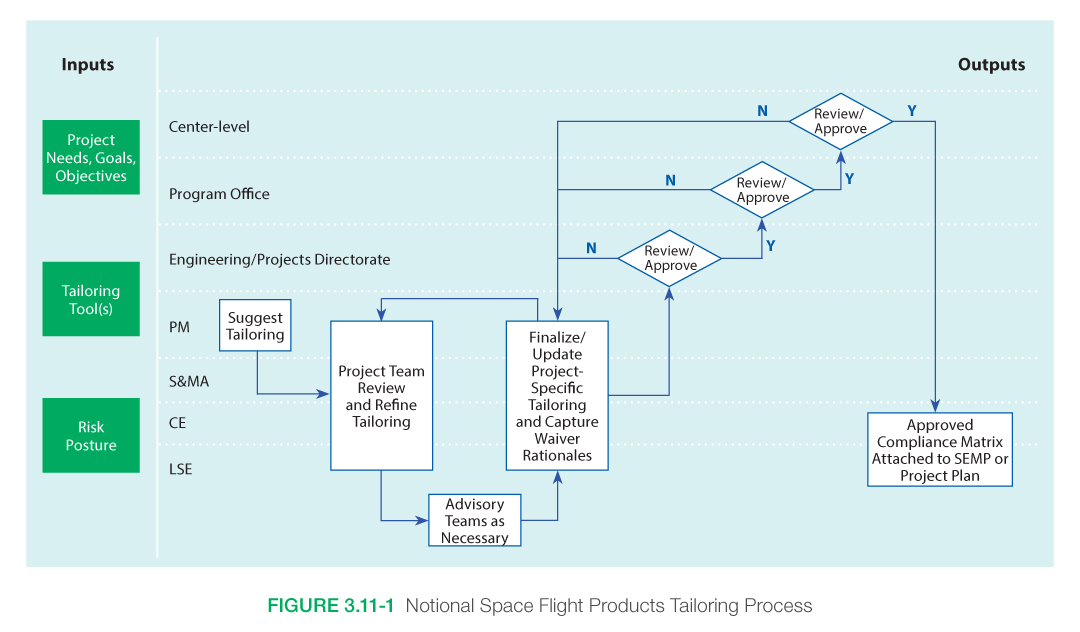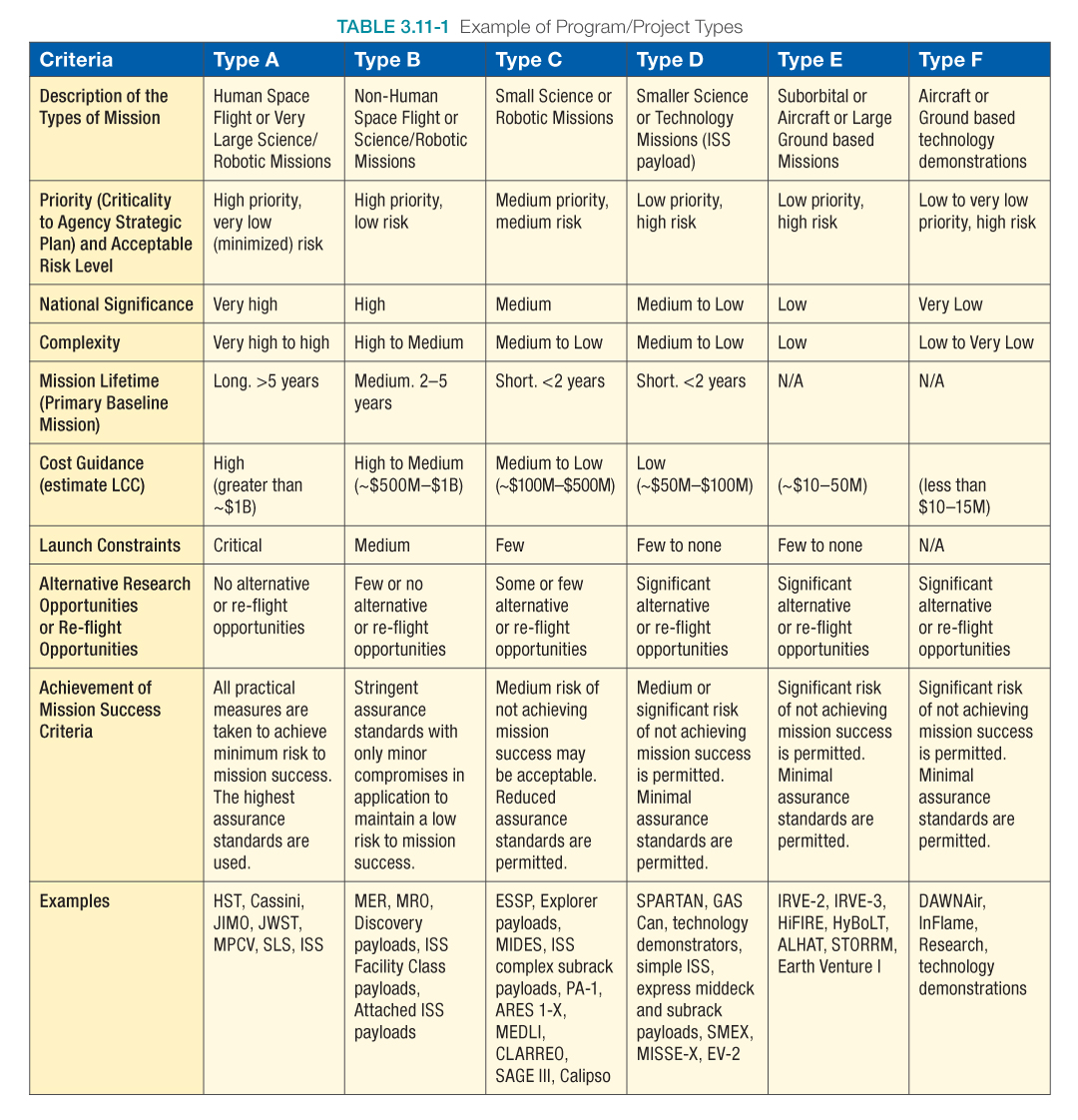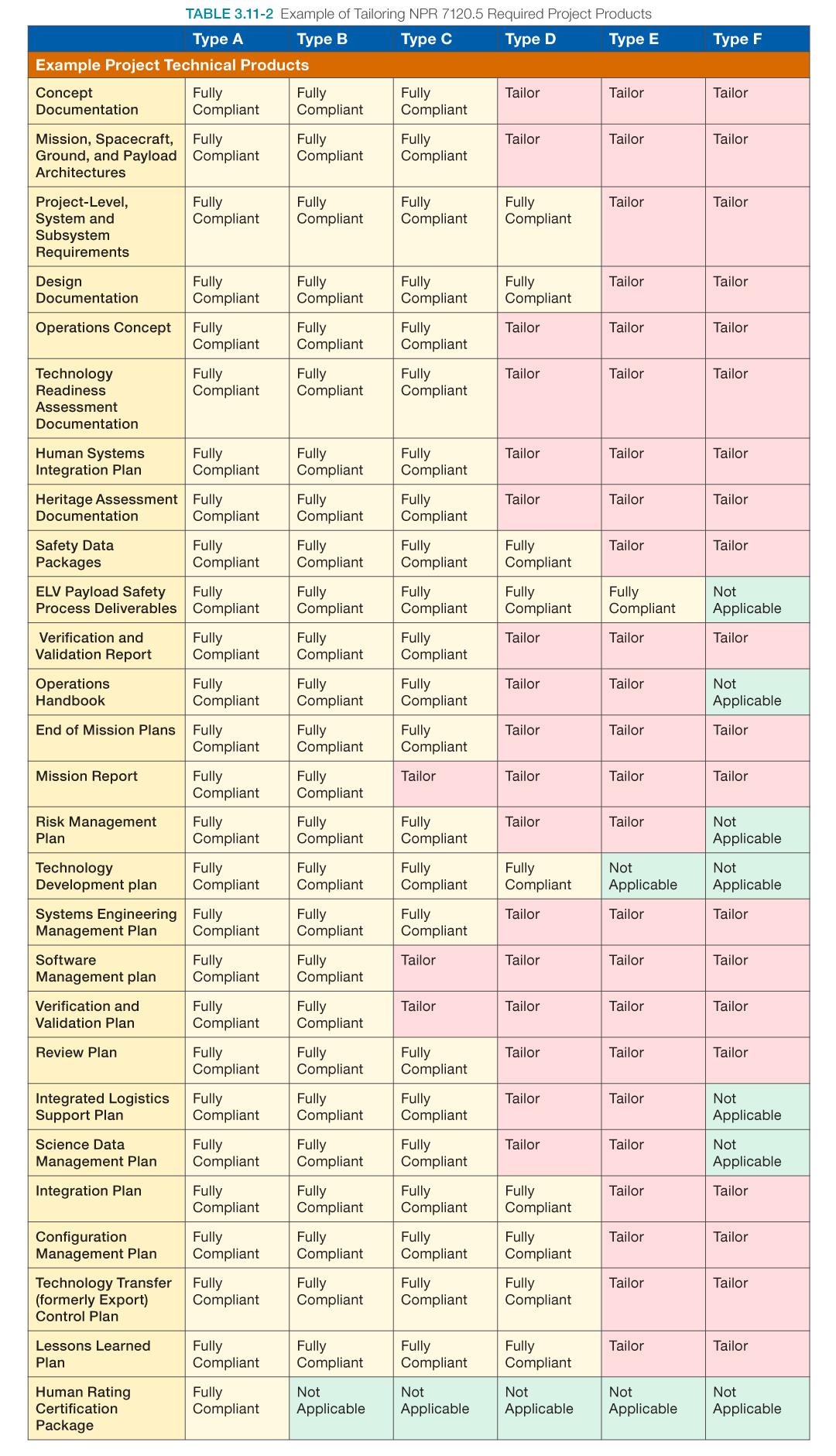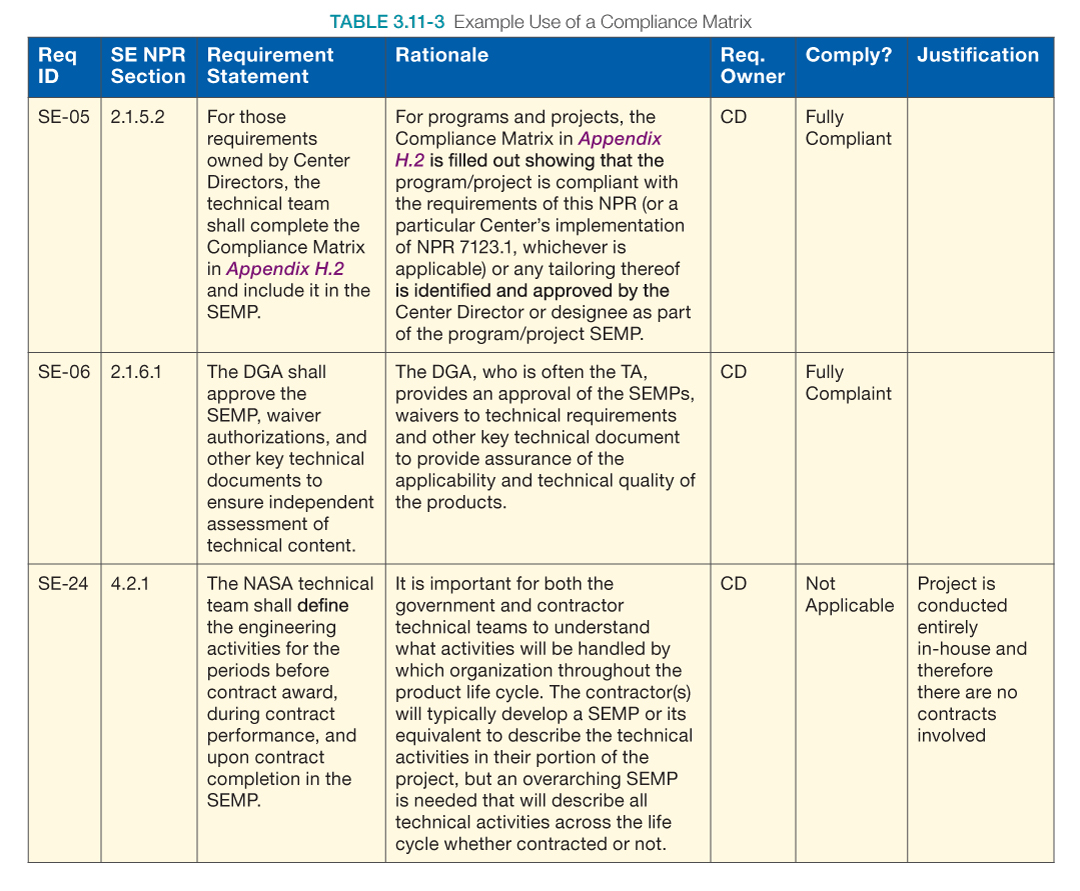Contents
- 3.11.1 Introduction
- 3.11.2 Criteria for Tailoring
- 3.11.3 Tailoring SE NPR Requirements Using the Compliance Matrix
- 3.11.4 Ways to Tailor a SE Requirement
- 3.11.4.1 Non-Applicable NPR Requirements
- 3.11.4.2 Adjusting the Scope
- 3.11.4.3 Formality and Timing of Reviews
- 3.11.5 Examples of Tailoring and Customization
- 3.11.6 Approvals for Tailoring
3.0 NASA Program/Project Life Cycle
3.1 Program Formulation
3.2 Program Implementation
3.3 Project Pre-Phase A: Concept Studies
3.4 Project Phase A: Concept and Technology Development
3.5 Project Phase B: Preliminary Design and Technology Completion
3.6 Project Phase C: Final Design and Fabrication
3.7 Project Phase D: System Assembly, Integration and Test, Launch
3.8 Project Phase E: Operations and Sustainment
3.9 Project Phase F: Closeout
3.10 Funding: The Budget Cycle
3.11 Tailoring and Customization of NPR 7123.1 Requirements
In this section, the term requirements refers to the “shall” statements imposed from Agency directives. This discussion focuses on the tailoring of the requirements contained in NPR 7123.1.
3.11.1 Introduction
3.11.2 Criteria for Tailoring
3.11.3 Tailoring SE NPR Requirements Using the Compliance Matrix
3.11.4 Ways to Tailor a SE Requirement
3.11.5 Examples of Tailoring and Customization
3.11.6 Approvals for Tailoring
3.11.1 Introduction
NASA policy recognizes the need to accommodate the unique aspects of each program or project to achieve mission success in an efficient and economical manner. Tailoring is a process used to accomplish this.
NPR 7123.1 defines tailoring as “the process used to seek relief from SE NPR requirements consistent with program or project objectives, allowable risk, and constraints.” Tailoring results in deviations or waivers (see NPR 7120.5, Section 3.5) to SE requirements and is documented in the next revision of the SEMP (e.g., via the Compliance Matrix).
Since NPR 7123.1 was written to accommodate programs and projects regardless of size or complexity, the NPR requirements leave considerable latitude for interpretation. Therefore, the term “customization” is introduced and is defined as “the modification of recommended SE practices that are used to accomplish the SE requirements.” Customization does not require waivers or deviations, but significant customization should be documented in the SEMP.
Tailoring and customization are essential systems engineering tools that are an accepted and expected part of establishing the proper SE NPR requirements for a program or project. Although tailoring is expected for all sizes of projects and programs, small projects present opportunities and challenges that are different from those of large, traditional projects such as the Shuttle, International Space Station, Hubble Space Telescope, and Mars Science Laboratory.
While the technical aspects of small projects are generally narrower and more focused, they can also be challenging when their objectives are to demonstrate advanced technologies or provide “one of a kind” capabilities. At the same time, their comparatively small budgets and restricted schedules dictate lean and innovative implementation approaches to project management and systems engineering. Tailoring and customization allow programs and projects to be successful in achieving technical objectives within cost and schedule constraints. The key is effective tailoring that reflects lessons learned and best practices. Tailoring the SE requirements and customizing the SE best practices to the specific needs of the project helps to obtain the desired benefits while eliminating unnecessary overhead. To accomplish this, an acceptable risk posture must be understood and agreed upon by the project, customer/stakeholder, Center management, and independent reviewers. Even with this foundation, however, the actual process of appropriately tailoring SE requirements and customizing NPR 7123.1 practices to a specific project can be complicated and arduous. Effective approaches and experienced mentors make the tailoring process for any project more systematic and efficient.
Chapter 6 of the NASA Software Engineering Handbook provides guidance on tailoring SE requirements for software projects.
3.11.2 Criteria for Tailoring
NPR 8705.4, Risk Classification for NASA Payloads, is intended for assigning a risk classification to projects and programs. It establishes baseline criteria that enable users to define the risk classification level for NASA payloads on human or non-human-rated launch systems or carrier vehicles. It is also a starting point for understanding and defining criteria for tailoring.
The extent of acceptable tailoring depends on several characteristics of the program/project such as the following:
- Type of mission. For example, the requirements for a human space flight mission are much more rigorous than those for a small robotic mission.
- Criticality of the mission in meeting the Agency Strategic Plan. Critical missions that absolutely must be successful may not be able to get relief from NPR requirements.
- Acceptable risk level. If the Agency and the customer are willing to accept a higher risk of failure, some NPR requirements may be waived.
- National significance. A project that has great national significance may not be able to get relief from NPR requirements.
- Complexity. Highly complex missions may require more NPR requirements in order to keep systems compatible, whereas simpler ones may not require the same level of rigor.
- Mission lifetime. Missions with a longer lifetime need to more strictly adhere to NPR requirements than short-lived programs/projects.
- Cost of mission. Higher cost missions may require stricter adherence to NPR requirements to ensure proper program/project control.
- Launch constraints. If there are several launch constraints, a project may need to be more fully compliant with Agency requirements.
3.11.3 Tailoring SE NPR Requirements Using the Compliance Matrix
NPR 7123.1 includes a Compliance Matrix (Appendix H.2) to assist programs and projects in verifying that they meet the specified NPR requirements. The Compliance Matrix documents the program/project’s compliance or intent to comply with the requirements of the NPR or justification for tailoring. The Compliance Matrix can be used to assist in identifying where major customization of the way (e.g., formality and rigor) the NPR requirements will be accomplished and to communicate that customization to the stakeholders. The tailoring process (which can occur at any time in the program or project’s life cycle) results in deviations or waivers to the NPR requirements depending on the timing of the request. Deviations and waivers of the requirements can be submitted separately to the Designated Governing Authority or via the Compliance Matrix. The Compliance Matrix is attached to the Systems Engineering Management Plan (SEMP) when submitted for approval. Alternatively, if there is no stand-alone SEMP and the contents of the SEMP are incorporated into another document such as the project plan, the Compliance Matrix can be captured within that plan.
Figure 3.11-1 illustrates a notional tailoring process for a space flight project. Project management (such as the project manager/the Principal Investigator/the task lead, etc.) assembles a project team to tailor the NPR requirements codified in the Compliance Matrix. To properly classify the project, the team (chief engineer, lead systems engineer, safety and mission assurance, etc.) needs to understand the building blocks of the project such as the needs, goals, and objectives as well as the appropriate risk posture.
Through an iterative process, the project team goes through the NPR requirements in the Compliance Matrix to tailor the requirements. A tailoring tool with suggested guidelines may make the tailoring process easier if available. Several NASA Centers including LaRC and MSFC have developed tools for use at their Centers which could be adapted for other Centers. Guidance from Subject Matter Experts (SMEs) should be sought to determine the appropriate amount of tailoring for a specific project. The Compliance Matrix provides rationales for each of the NPR requirements to assist in understanding. Once the tailoring is finalized and recorded in the Compliance Matrix with appropriate rationales, the requested tailoring proceeds through the appropriate governance model for approval.
3.11.4 Ways to Tailor a SE Requirement
Tailoring often comes in three areas:
- Eliminating a requirement that does not apply to the specific program/project.
- Eliminating a requirement that is overly burdensome (i.e., when the cost of implementing the requirement adds more risk to the project by diverting resources than the risk of not complying with the requirement).
- Scaling the requirement in a manner that better balances the cost of implementation and the project risk.
Customizing SE practices can include the following:
- Adjusting the way each of the 17 SE processes is implemented.
- Adjusting the formality and timing of reviews.
3.11.4.1 Non-Applicable NPR Requirements
Each requirement in NPR 7123.1 is assessed for applicability to the individual project or program. For example, if the project is to be developed completely in-house, the requirements of the NPR’s Chapter 4 on contracts would not be applicable. If a system does not contain software, then none of the NPR requirements for developing and maintaining software would be applicable.
3.11.4.2 Adjusting the Scope
Depending on the project or program, some relief on the scope of a requirement may be appropriate. For example, although the governing project management directive (e.g., NPR 7120.5, 7150.2, 7120.7, 7120.8) for a program/project may require certain documents to be standalone, the SE NPR does not require any additional stand-alone documents. For small projects, many of the plans can be described in just a few paragraphs or pages. In these types of projects, any NPR requirements stating that the plans need to be stand-alone document would be too burdensome. In these cases, the information can simply be written and included as part of the project plan or SEMP. If the applicable project management directive (e.g., NPR 7120.5 or NPR 7120.8) requires documents to be stand-alone, a program/project waiver/deviation is needed. However, if there is no requirement or Center expectation for a stand-alone document, a project can customize where that information is recorded and no waiver or deviation is required. Capturing where this information is documented within the systems engineering or project management Compliance Matrix would be useful for clarity.
3.11.4.3 Formality and Timing of Reviews
The governing project management directive identifies the required or recommended life cycle for the specific type of program/project. The life cycle defines the number and timing of the various reviews; however, there is considerable discretion concerning the formality of the review and how to conduct it. NPR 7123.1, Appendix G, provides extensive guidance for suggested review entrance and success criteria. It is expected that the program/project will customize these criteria in a manner that makes sense for their program/project. The SE NPR does not require a waiver/deviation for this customization; however, departures from review elements required by other NPRs need to be addressed by tailoring those documents.
If a program/project decides it does not need one of the required reviews, a waiver or deviation is needed. However, the SE NPR does not specify a minimum amount of spacing for these reviews. A small project may decide to combine the SRR and the SDR (or Mission Definition Review (MDR)) for example. As long as the intent for both reviews is accomplished, the SE NPR does not require a waiver or deviation. (Note that even though the SE NPR does not require it, a waiver or deviation may still be required in the governing project management NPR.) This customization and/or tailoring should be documented in the Compliance Matrix and/or the review plan or SEMP.
Unless otherwise required by the governing project management directives, the formality of the review can be customized as appropriate for the type of program/project. For large projects, it might be appropriate to conduct a very formal review with a formal Review Item Discrepancy (RID)/Request for Action (RFA) process, a summary, and detailed presentations to a wide audience including boards and pre-boards over several weeks. For small projects, that same review might be done in a few hours across a tabletop with a few stakeholders and with issues and actions simply documented in a word or PowerPoint document.
The NASA Engineering Network Systems Engineering Community of Practice, located at https://nen.nasa.gov/web/se includes document templates for milestone review presentations required by the NASA SE process.
3.11.5 Examples of Tailoring and Customization
Table 3.11-1 shows an example of the types of missions that can be defined based on a system that breaks projects into various types ranging from a very complex type A to a much simpler type F. When tailoring a project, the assignment of specific projects to particular types should be viewed as guidance, not as rigid characterization. Many projects will have characteristics of multiple types, so the tailoring approach may permit more tailoring for those aspects of the project that are simpler and more open to risk and less tailoring for those aspects of the project where complexity and/or risk aversion dominate. These tailoring criteria and definitions of project “types” may vary from Center to Center and from Mission Directorate to Mission Directorate according to what is appropriate for their missions. Table 3.11-2 shows an example of how the documentation required of a program/project might also be tailored or customized. The general philosophy is that the simpler, less complex projects should require much less documentation and fewer formal reviews. Project products should be sensibly scaled.
3.11.6 Approvals for Tailoring
Deviations and waivers of the requirements for the SE NPR can be submitted separately to the requirements owners or in bulk using the appropriate Compliance Matrix found in NPR 7123.1 Appendix H. If it is a Center that is requesting tailoring of the NPR requirements for standard use at the Center, Appendix H.1 is completed and submitted to the OCE for approval upon request or as changes to the Center processes occur. If a program/project whose responsibility has been delegated to a Center is seeking a waiver/deviation from the NPR requirements, the Compliance Matrix in Appendix H.2 is used. In these cases, the Center Director or designee will approve the waiver/deviation.
The result of this tailoring, whether for a Center or for a program/project, should also be captured in the next revision of the SEMP along with supporting rationale and documented approvals from the requirement owner. This allows communication of the approved waivers/deviations to the entire project team as well as associated managers. If an independent assessment is being conducted on the program/project, this also allows appropriate modification of expectations and assessment criteria. Table 3.11-3 provides some examples of tailoring captured within the H.2 Compliance Matrix.

































